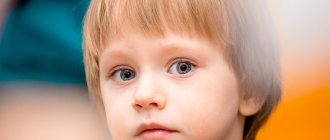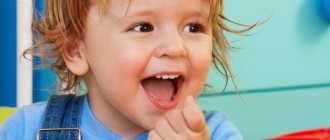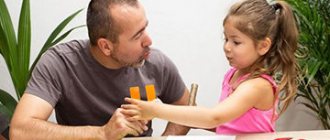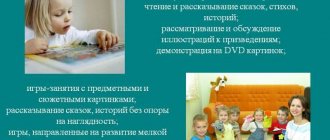Children learn to communicate with adults and speak in the first year of life, but clear and competent pronunciation is not always achieved by the age of five. Often kindergartens, where a child among peers learns to speak more intensively and dramatically increases vocabulary, knowledge and understanding, become unwitting participants in involving the child in the process of active speaking. However, there is no doubt that the pace of technology development and children’s knowledge of household appliances and computer devices often give adults a head start, but speech skills are left far behind. And by the age of four or five years, a child is sometimes unable not only to pronounce sounds correctly, but also to formulate a thought.
The consensus of pediatricians, child psychologists and speech pathologists is the same: a child should limit access to computer games and, if possible, replace them with outdoor games, didactic materials and educational games: lotto, dominoes, mosaics, drawing, modeling, appliqués, etc. d. The child should pay constant attention, if possible, encourage each new achievement in correct pronunciation with emotions of delight, joy, and praise, and constantly train the muscles of the palate, tongue, lips and pharynx.
Causes of speech disorders
If a child speaks less than twenty simple words per year, you need to pay attention to how the elders communicate with the younger ones in the family, what is the general psychological background in the family, the relationships of family members and ways of raising children.
If, according to the psychologist, the child’s mental state is good, hearing and intelligence are normal, speech therapy classes with children 3-4 years old will correct the pronunciation and allow the child to learn to speak correctly faster.
Sometimes, for a number of reasons of a neurological, physical or mental nature, speech disorders result in a certain form.
This may be caused by a lack of vocabulary, incorrect pronunciation of words, confusion in the endings or rearrangement of syllables of a word, and there may also be manifestations in the pace of speech.
Speech imitation
A child’s reproduction of sounds, words, and phrases is called speech imitation.
It is meaningful only when speech is closely related to the child’s actions.
An adult should stimulate the child's speech with questions.
Words to be repeated must be pronounced many times; do not repeat the child’s “substitute words.” The child’s answers are accepted in any form.
The most important thing is to do everything possible so that the child does not hesitate to speak. Speech imitation goes through several stages:
Speech imitation goes through several stages:
- Copying sounds that have a certain meaning.
- Repetition of amorphous words (kup-kup - swim, am-am - eat, lalya - doll).
- Repetition of simple words (baba, grandfather, drink).
- Repeating short phrases: “Give me the juice!” Where's the spoon?
Pay great attention to the use of verbs. If a child’s speech contains many action words, his level of development is quite high.
Games with speech imitation
For example:
They love... (monkeys) very much
Eat sweets... (bananas).
We are like monkeys... (look like)
And we love bananas... (too).
Gradually, the number of pauses (words skipped by adults) can be increased, thereby increasing the child’s vocabulary.
Fun games in the form of a conversation: an adult repeats a word several times, then asks the child a question, the answer to which is the highlighted word. If the question is answered correctly, the adult praises the child; if the question is answered incorrectly, he answers the question himself or offers several answer options.
How to identify a speech disorder
As a rule, in early childhood, children do not develop at the same rate, so it is quite difficult to classify any disorder based on external general signs of health. With careful attention to a small family member, manifestations of violations can be noticed by parents and older children.
Speech therapy classes begin with children 3-4 years old, when a certain vocabulary is normally formed, and the child actively communicates or is forced to strive to explain his needs and desires verbally, and not through gestures. Psychologists note this age also because personal growth, simultaneously with new forms of thinking and self-identification, makes the child interested in new things and strives to communicate, especially to communicate with peers. Thanks to the fact that children themselves teach each other to explain themselves more clearly in a playful and natural way, the vocabulary and, accordingly, the speech of a child at 3-4 years old changes.
For children 2 – 3 years old
Experts have established a standard of words that children over two years old should know. It is generally accepted that children of this age should have about fifty words in their vocabulary.
Of course, every little person is born with their own individual characteristics. Some start speaking earlier, others later. But it all comes down to how parents approach the issue of shaping the speech structure of their children.
There are certain rules - exercises that must be carried out in the development of speech in children 2 - 3 years old:
We study objects of the surrounding world together
In the process of performing any action, be sure to describe everything that happens. At this age, little people absorb all information like sponges and actively explore the world. They try to touch everything, feel it by touch.
The main rule of parents is to describe all the baby’s actions. If he picks up an object, be sure to say its name and describe its external characteristics. Praise for any activity in your baby's behavior
Pay attention to what he is doing.
Let's get acquainted with the illustrations
There are many books with colorful, bright images. They will help form the baby’s understanding of the world around him and improve his vocabulary. Buy books for the little ones. Show the illustrations to the children and ask questions about the pictures. “How can a dog? – AB – AB.” When studying animals from pictures, try to see them in the real world
Be sure to focus your child’s attention on the fact that this animal is alive, and this one is drawn in a book
Sound notations
Try to highlight any actions that the toddler performs with sounds. When clapping your hands, repeat “CLAP - CLAP.” When stamping your feet: “TOP - TOP.” The ball knocks: “BOOM - BOOM.” By pronouncing various sounds, the baby eventually realizes that each action entails a certain sound.
Repeat sound
The little one plays the sounds, ask them to say them again and consolidate the acquired skill. Example: “How does a cow moo? - “MU.” If the little man makes an incomprehensible statement, repeat it after him. This will help encourage your baby to pronounce the word correctly. Don't forget to reward your baby for her success and efforts.
And it’s even more fun to study and guess the sounds in the song about the blue tractor and combine them with dance moves, as in the video:
Speech therapist test for parents - a signal to action
Test tasks given by speech therapists allow you to determine the level of impairments or identify the absence of impairments in a child. Often, some time devoted to classes captivates the child, he gets involved in completing tasks with interest, and after a short time begins to speak much better and more correctly. If speech disorders are nevertheless identified, parents should know that they can often be easily corrected, provided that classes and exercises with the child are carried out not only in a group with a speech pathologist or speech therapist, but also at home.
Educational "guest" games with several objects
Game "Hide and Seek". The goal is to understand and actively use in speech the prepositions of place “on”, “in”, “under”, “above”, “at/about”. Place children's furniture on the table. “Here we have a room where the girl Lisa lives. Name all the objects in Lisa's room. What word can be used to name all these objects? - Furniture. – Her friends came to visit Lisa - frogs, ducklings, bear cubs. They started playing hide and seek. The little frogs jumped onto the table. The cubs crawled under the bed. The ducklings hid behind the chair. Lisa went to look for animals. Not on the sofa, not under the chair. Who will help Lisa find her little friends? Where are the cubs? Where are the ducklings? The game can be repeated several times. Animal toys may change.
Game “Requests and Instructions”. The goal is to develop skills in constructing the imperative mood. Cat and Bunny are visiting Lisa. If you want the Bunny to do something, ask him about it. “Bunny, jump!”, “Cat, dance!”, “Cat, lie down on the sofa!”, “Bunny, hide!” Encourage your baby to use prefixes to form verbs that denote different actions: jump - jump - jump - jump over, move away - leave - come in - come.
Classes should be daily. Start with 15 minutes and gradually work your way up to a normal school lesson of 40 minutes. Make sure your child understands what is being said and does not automatically repeat what he hears. It would be great if the child would practice such games not only at home, but also with his peers. The task of teaching a 3-year-old child to speak well is quite feasible if you do not retreat, do not give in to difficulties and believe in what you are doing (we recommend reading: how to teach a child to read syllables correctly and smoothly?).
What does a speech therapy session include?
During psychological and speech therapy classes for children 3-4 years old, the child’s education is simultaneously carried out not only in the speech sense, because the related processes of brain activity, speech functions, and motor skills in combination must be carried out in different directions:
- you need to develop general, fine motor skills (modeling, drawing, rolling, clapping, clenching and unclenching your fists, tapping your fingers, lacing, fastening and unfastening buttons will help here);
- It is equally important to develop articulatory motor skills (regular exercises for the muscles of the tongue, lips, larynx and palate);
- correction of sound pronunciation, correct production of sounds by a speech therapist;
- correction of errors in diction and training in rhythm, smoothness of speech and diction.
About rhymes and tongue twisters
Tongue twisters are a very effective type of exercise. They should be selected for those letters and sounds in the pronunciation of which the baby has the most serious gaps. There are many benefits from them - it is in improving diction, and in the development of speech hearing, and in expanding the vocabulary. In addition, it is interesting and fun for a child to pronounce short, funny rhyming lines.
Speech therapy gymnastics is continued in poetry, the task of which is to increase the amount of what is understood and pronounced. An active vocabulary, as you know, is what a child says, a passive one is what he understands. The second is always an order of magnitude more extensive. For general development and the transition from passive to active vocabulary, you should communicate a lot with your baby in any circumstances - on a walk, on the way to kindergarten, at the table, etc.
If you are not lazy and use the slightest opportunity for such communication, creatively weaving tongue twisters, games for hands and fingers, and articulation exercises into everyday life, then the result will definitely come.
What are the benefits of speech therapy exercises?
The description of a speech therapy session for children 3-4 years old includes mandatory articulation gymnastics to relieve muscle tone and spasm, dynamic and static exercises for the tongue, corners of the lips, muscles of the lower jaw, cheeks, finger exercises and fine motor skills, sometimes reflexology massage. During corrective classes, children learn spatial concepts, develop motor skills and memory, visual images, attention, thinking and observation. Sensory functions develop, constructive thinking is practiced, and muscle tone is gradually normalized.
Psychological aspect of working with a child
Features of speech therapy classes with children 3-4 years old may relate to the psychological component; often children with speech impairments, due to contrasting themselves with those who speak well, become complex or withdraw into themselves. The teacher’s task is to win over the child, interest him and force him to overcome the barriers he himself has created regarding his own characteristics. The downside may be to oppose oneself in a conflicting manner, indiscipline, whims, and refusal to work together. In this case, individual speech therapist lessons are recommended for children 3-4 years old - it is easier to convince and interest a special child in private when an adult becomes the child’s friend and assistant, able to see the efforts behind the whims.
We focus on logorhythmics
Logorhythmics involves the simultaneous use of speech and motor activity accompanied by cheerful musical accompaniment. An adult only needs to read a short poem, actively gesturing with his hands. The baby must repeat all this, but only in his “repertoire”. Experts recommend conducting such speech therapy sessions with the child in the afternoon.
Depending on the individual characteristics of the body, which are just being formed at the age of three, and some other (both internal and external) factors, the final result from classes manifests itself in different ways. Some children immediately grasp everything “on the fly” and after a few weeks confidently pronounce words. Others take a little longer to adapt and get used to. In any case, the result will only be positive. As they say, everything has its time, but the most important thing is not to miss this time at the very beginning, when problems only make themselves felt.
https://youtube.com/watch?v=YlXEEAQfN0Y
Read further:
What are articulatory motor skills?
Developmental exercises for your baby
How to develop speech in a preschooler?
General developmental classes
Physical education, although not included in the set of exercises with a speech therapist, is still important; gymnastics develops the correct breathing pattern, which, in turn, contributes to better saturation of the brain with oxygen and good blood circulation. Speech therapy classes with children 3-4 years old are often accompanied by the development of fine motor skills with available tools in the form of puzzles, mosaics, origami, construction sets, drawing and games aimed at developing mnemonic memory. In addition, memory is trained with riddles in poetic form, tongue twisters and poems on a funny theme. Of course, training is carried out in a playful way, otherwise the child may flatly refuse to do exercises and gymnastics. The task of the speech therapist and parents is to participate in the development of the child’s correct speech as fully as possible, because the earlier violations are noticed, the greater the chance of eradicating them and helping the child communicate beautifully and correctly, and therefore become a competent and pleasant interlocutor.
4.Guess the riddle - show me the answer!
Goal: clarification and expansion of children’s passive subject vocabulary on various topics; teach children to recognize objects by their purpose; development of children's thinking. Materials: subject pictures on various topics. Progress of the game: The game is played on the carpet. Place the children in a circle on the floor. Place object pictures face up in front of them. You can give general instructions for everyone, or you can give instructions individually for each child. And now we will solve riddles. Let's see which of you is the most attentive. Show what people eat the soup with (the picture is a “spoon”). Show what is rolling (the picture is “ball”). Show what you can use to draw with (the picture is a “pencil”). Show what is put on the head (picture “hat”) Find and show something that can be eaten (pictures – “apple”, “candy”, “cheese”) Etc. If children find it difficult to find the right picture, you can give a more detailed description of the desired item. If the children could not find the right picture, you should show them a real object, describe its properties, and play with it.






